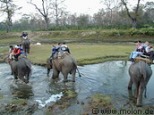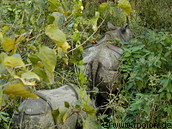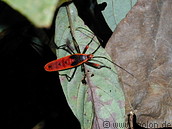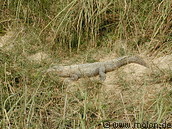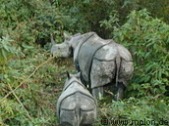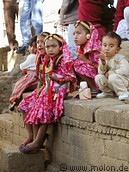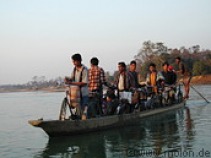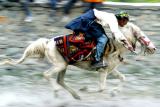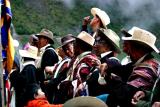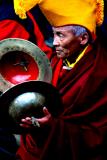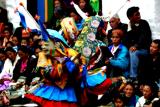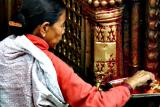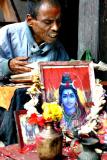Nepal's history
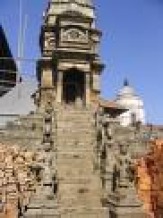
Nepal has seen many rulers and ruling dynasties. The earliest rulers were the Kirantis who ruled from 9th century B.C. to 1st century A.D. Legends and chronicles mention that the Indian Emperor Ashoka had come to Nepal and visited Lumbini, the place where the Buddha was born, and where he erected a huge stone pillar to commemorate his visit to that spot.
The Kirants were replaced by Licchavis who, according to the earliest evidences in inscriptions of the 5th century A.D. found in the courtyard of Changunarayan temple which is about 15 km north east of Kathmandu, ruled this country from 1st century to 9th century A.D. This period is noted for the many temples and fine sculptures built around the Kathmandu valley.
The Licchavis were followed by the Thakuris, then came the Malla dynasty. The Mallas ruled focusing mainly on the Kathmandu Valley which has been the residence for most Nepali rulers from time immemorial. No other part of Nepal is as rich in cultural heritage as Kathmandu. Thanks to the exceptionally talented crafts-men, who dedicated themselves to construct the many temples and statues, we have seven world heritage sites in the Kathmandu Valley itself.
In the 14th century A.D. King Jayasthiti Malla established a rigid social order. His grandson tried in every way to protect his country from suspected enemy states. Unfortunately, all his efforts were fruitless, everything went beyond his control and the country eventually divided up into 50 small feudal states including the three major ones in the valley.
Then came the Shah dynasty. King Prithvi Narayan Shah who annexed small principalities including three states in the Kathmandy Valley and unified Nepal in a single kingdom. Recognizing the threat of the British Raj in India, he dismissed European missionaries from the country and for more than a century, Nepal remained in isolation. During the mid-19th century Jung Bahadur Rana became Nepal's first prime minister to wield absolute power. The Ranas were overthrown in a democracy movement of the early 1950s.
Nepal was declared a Federal Democratic Republic state on May 28, 2008, during the first meeting of the Constituent Assembly. It was previously a multiparty democracy since 1990.
About Nepal
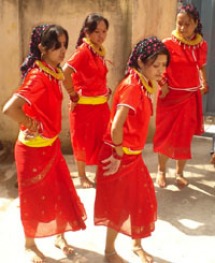
Nepal is one of the richest countries in the world in terms of bio-diversity due to its unique geographical position and altitude variation. The elevation of the country ranges from 60 meters above sea level to the highest point on earth, Mt. Everest at 8,848 meters, all within a distance of 150 kilometers resulting in climatic conditions from sub-tropical to arctic.
This wild variation fosters an incredible variety of ecosystems, the greatest mountain range on earth, thick tropical jungles teeming with a wealth of wildlife, thundering rivers, forested hills and frozen valleys.
Within this spectacular geography is also one of the richest cultural landscapes anywhere. The country is a potpourri of 101 ethnic groups and sub-groups who speak over 92 languages and dialects. Nepal offers an astonishing diversity of sightseeing attractions and adventure oppurtunities found nowhere else on earth. And you can join in the numerous annual festivals that are celevrated throughout the year in traditional style highlighting enduring customs and beliefs.
Language: Nepali
Currency: Nepalese Rupee
Political System: Nepal was declared a Federal Democratic Republic state on May 28, 2008, during the first meeting of the Constituent Assembly. It was previously a multiparty democracy since 1990
National Bird: Impean Pheasant Danfe).
National Flower: Rhododendron Arboreum (Lali Gurans).
The most exhilarating titles with which Nepal has been admired and praised by various renowned travel writers in recognition of her cultural richness :
*Living cultural Museum
* Shangri-La
*Roof of the World
*Birth place of the Apostle of Peace
*Country of Living Goddess
*City of Golden Pagodas and Parasols
*Himalayan Pilgrimage
*Nature amphitheatre
*Melting pot of Hinduism and Buddhism
*A tiny Kingdom of 103 ethnic groups and 93 spoken languages
*Birth place of Sita
*Abode of Shiva
*Land of Mysticism & Exoticism
*Land of non-stop festivals
are explicit and self-explanatory. They tell the world about our incomparable & prosperous cultural heritage.
Peoples and Customs
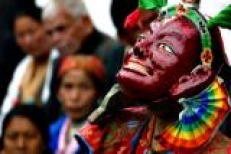
The population of Nepal was recorded to be about 25 million as of July 2002. Eighty-six percent of Nepalis follow Hinduism, while eight percent follow Buddhism and three percent follow Islam. The population comprises various groups of different races which are further divided into different castes. The distinction in caste and ethnicity is understood more easily with a view of customary layout of the population.
Some of the main groups are such: Gurungs and Magars who live mainly in the western region; Rais, Limbus and Sunwars who live in the eastern mid hills; Sherpas, Manangpas and Lopas who live near the mountains of Everest, Annapurna and Mustang respectively; Newars who live in and around the capital valley of Kathmandu; Tharus, Yadavas, Satar, Rajvanshis and Dhimals who live in the Terai region; and Brahmins, Chhetris and Thakuris generally spread over all parts of the country.
Nepali is the official language of the state, spoken and understood by 100 percent of the population. Multiple ethnic groups speak more than a dozen other languages in about 93 different dialects. English is spoken by many in government and business offices. It is the mode of education in most private schools of Kathmandu and some other cities.
Ethnic Distribution The Northern Himalayan People In the northern region of the Himalayas are the Tibetan-speaking groups namely Sherpas, Dolpas, Lopas, Baragaonlis, Manangis. The Sherpas are mainly found in the east in the Solu and Khumbu region; the Baragaonlis and Lopas live in the semi-deserted areas of Upper and Lower Mustang in the Tibetan rain-shadow area; the Managis live in Manang district area; while the Dolpas live in Dolpa district of West Nepal, one of the highest settlements on earth at 4,000 meters.
The Middle Hills and Valley People Several ethnic groups live together in harmony in the middle hills and valleys. Among them are the Magars, Gurungs, Tamangs, Sunuwars, Newars, Thakalis, Chepangs and majority of Brahmans and Chhetris. The Brahmans and Chhetris have long dominance in all pervading social, religious and political realms. There are also some occupational castes namely: Damai (tailor), Sarki (cobbler), Kami (blacksmith) and Sunar (goldsmiths). Though, there exist numerous dialects, the language of unification is the national language, Nepali.
Ethnic Diversity in the Kathmandu Valley Kathmandu Valley represents a cultural cauldron of the country, where, people from varied backgrounds have come together to present a melting pot. The natives of the Kathmandu Valley are the Newars. Newari culture is an integration of both Hinduism and Buddhism. The Newars of Kathmandu Valley were traders or farmers by occupation in the old days.
The Terai People The main ethnic groups in Terai are Tharus, Darai, Kumhal, Majhi and other groups that have roots in India. They speak north Indian dialects like Maithili, Bhojpuri. Owing to the fertile plains of Terai, most inhabitants live on agriculture. There are, however, some occupational castes like Majhi (fisherman), Kumhal (potter) and Danuwar (cart driver).
POPULATION OF MAJOR ETHNIC GROUPS ETH. GROUP POPULATION
Brahman 2896477
Chhetri 3593496
Chepang 52237
Gurung 543571
Limbu 359379
Muslim 971056
Magar 1662241
Newar 1245232
Rai 635151
Raute 658
Sherpa 15462
Tharu 1533879
Thakuri 334120
Thakali 12973
Tamang 1282304
Religion
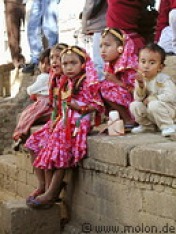
In Nepal, Hinduism and Buddhism are the two main religions. The two have co-existed down the ages and many Hindu temples share the same complex as, Buddhist shrines. Hindu and Buddhist worshippers may regard the same god with different names while performing religious rites.
Nepal has been declared as a secular country by the Parliament on May 18, 2006. Religions like Hindusim Buddhism, Islam, Christianity, and Bon are practiced here. Some of the earliest inhabitants like the Kirats practice their own kind of religion based on ancestor worship and the Tharus practice animism. Over the years, Hinduism and Buddhism have been influenced by these practices which have been modified to form a synthesis of newer beliefs.
For centuries the Nepal remained divided into many principalities. Kirats ruled in the east, the Newars in the Kathmandu Valley, while Gurungs and Magars occupied the mid-west. The Kirats ruled from 300 BC and during their reign, emperor Ashoka arrived from India to build a pillar at Lumbini in memory of Lord Buddha. The Kirats were followed by the Lichchhavis whose descendants today are believed to be the Newars of the Kathmandu Valley. During this period, art thrived in Nepal and many of the beautiful woodcarvings and sculptures that are found in the country belong to this era. With the end of the Lichchhavi dynasty, Malla kings came to power in 1200 AD and they also contributed tremendously to Nepal's art and culture. However, after almost 600 years of rule, the kings were not united among themselves and during the late 18th century, Prithvi Narayan Shah, King of Gorkha, conquered Kathmandu and united Nepal into one kingdom. Recognizing the threat of the British Raj in India, he dismissed European missionaries from the country and for more than a century, Nepal remained in isolation. During the mid-19th century Jung Bahadur Rana became Nepal's first prime minister to wield absolute power. He set up an oligarchy and the Shah kings remained figureheads. The Ranas were overthrown in a democracy movement of the early 1950s.
Religious Festivals
Most of the festivals celebrated in Nepal have religious significance. The dates of most festivals are fixed by famous astrologers after consulting the lunar calendar. The biggest and most popular festivals are: Dashain, a celebration of Goddess Bhagabati's victory over evil Mahisashur; and Tihar, a celebration of lights dedicated to Goddess Laxmi.
Nature
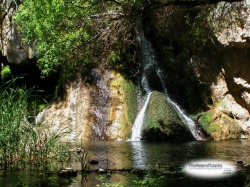
Nepal covers a span of 147,181 sq. kilometers ranging from altitude of 70 meters to 8,848 meters. Mountains, mid hills, valleys and plains dominate the geography of landlocked Nepal that extends from the Himalayan range in the north to the Indo-Gangetic lowlands in south. Mt. Everest, the highest point of the Himalayas is in Nepal. Physical features also include green paddy terraces, wind-swept deserts, dense forests and marshy grasslands. The country is well endowed with perennial rivers, lakes and glacial lakes that originate in the Himalayas. Twenty percent of the land in the country is used for agriculture, where 0.49 percent is used for permanent crops, mainly rice.
Climatic conditions of Nepal vary from one place to another in accordance with the geographical features. In the north summers are cool and winters severe, while in south summers are sub tropical and winters mild.
The variety in Nepal's topography provides home to wildlife like tigers, rhinos, monkeys, bears, yaks, leopards and different species of insects and birds. Nepal is a home to almost 10 percent of the world's bird species among which 500 species are found in the Kathmandu Valley.
The country has managed to preserve some endangered species of Asia in its extensive parks and protected natural habitats. The most abundant natural resource in Nepal is water. Other resources found here are quartz, timber, lignite, copper, cobalt, iron ore and scenic beauty.
More about nature, click here
| Check Page Rank of any web site pages instantly: |
| This free page rank checking tool is powered by PRAKASH service |
